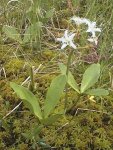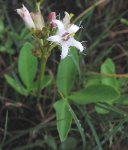Triple-leaf watch - menyanthes trifoliata l.
Family of Watchmen - Menyanthaceae
Other names. Trifol, trefoil of water.
Botanical characteristics. Perennial herbaceous plant.
Rhizome long, creeping, covered with scales. Leaves are simple, triple, long-petioled with elliptical segments. Inflorescence is an oblong brush. Flowers are pale pink or white funnel-shaped. Fruit is a box. Blooms in May - June. Fruits ripen in July - August.
Spread. It is widely distributed practically on all territory of the country. It grows in all areas of the Far East. It grows in shallow water: in swamps, along the shores of lakes and streams, on wet meadows. It grows on mossy marshes, in solitary water and thickets.
Used parts of the plant. The medicinal raw material is the aboveground portion of the plant, more often leaves collected during budding or during flowering. Dry in dryers at a temperature of no higher than 35-40 ° C.
Chemical composition. The aerial part of the plant contains triterpenoids: loganin, betulinic acid and other alkaloids: foliamntin; Phenolic carboxylic acids, steroids, carbohydrates and related compounds: glucose, fructose, sucrose, meniatin, melianthin; Saponins, flavonoids, fatty oil. The roots contain saponins, tannins, flavonoids.
Application. The leaves are part of the domestic pharmacopoeia. Galenic preparations of the watch are used as an appetizing stimulant and conducive to increased gastrointestinal secretion, with gastritis with reduced acidity, with constipation and flatulence, and also as an antipyretic agent. Included in the collection of appetizing, choleretic, laxatives, diuretic, sedatives.
Often decoctions and infusions of the watch are used for washing trophic ulcers and difficult healing wounds. Taking baths - for skin and mucous membrane diseases.
In homeopathy - essence - with headache, trigeminal neuralgia, rheumatism, in dentistry - with periodontitis, stomatitis and toothache.
In folk medicine, the aerial part of the plant in the form of decoctions and infusions of leaves is used for diseases of the liver, gall bladder, gastritis, dysentery, malaria, scurvy, pulmonary tuberculosis, dyspepsia, fever, migraine, antigelmintic, respiratory infections, Severe diseases, to stimulate appetite.
In the experiment, fresh juice and infusion of leaves have an anti-inflammatory effect.
Tibetan medicine uses a rhizome with chronic gastroenteritis; In the Komi-Permyak Autonomous Okrug, the roots are used for various respiratory infections; In Nanais - with pulmonary tuberculosis; In the Caucasus - with hypoxecretion of the stomach.
Preparation. To obtain the infusion, take 10 g of leaves or the aerial part of the plant, pour boiling water, heat in a water bath for 15 minutes, cool for 45 minutes, filter, bring to 200 ml, otzhivaya residue. Take 1/3 cup 3 times a day.




Comments
Commenting on, remember that the content and tone of your message can hurt the feelings of real people, show respect and tolerance to your interlocutors even if you do not share their opinion, your behavior in the conditions of freedom of expression and anonymity provided by the Internet, changes Not only virtual, but also the real world. All comments are hidden from the index, spam is controlled.